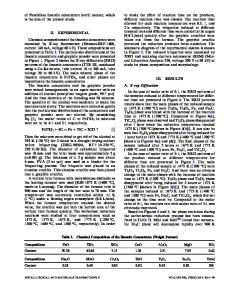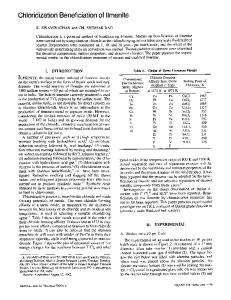Formation of TiN/TiC-Fe composites from ilmenite (FeTiO 3 ) concentrate
- PDF / 1,424,544 Bytes
- 7 Pages / 612 x 792 pts (letter) Page_size
- 18 Downloads / 291 Views
I.
INTRODUCTION
In recent years, the production of hard materials has become increasingly important with alternative routes being investigated for their cost and suitability. Among the most important hard materials are titanium nitride and titanium carbide, which have many uses such as coatings on cutting tools. The usual method of formation of the carbide is by direct reaction between pure titanium dioxide and graphite under vacuum at temperatures up to 1900 7C.[1,2,3] The same reduction reaction in the presence of nitrogen forms the nitride at 1250 7C.[1] Both of these phases can also be formed by the mechanical alloying of titanium metal with carbon[4,5] or either nitrogen or ammonia in a sealed ball mill;[6,7,8] however, these processes require the extraction and purification of titanium metal, which is a costly process. Ball milling under controlled conditions has been used to activate reactions that otherwise require more extreme thermal treatment and to cause reactions to occur under conditions where more conventional processing techniques are ineffective.[9] Recent work[10] has shown that rutile reduction to TiC or TiN can be achieved at temperatures below 1200 7C and 1000 7C, respectively, considerably below the temperatures used in industry. A logical extension of earlier work[10] would be to use the mineral precursor of rutile, ilmenite, as the starting material. The use of ilmenite would remove the necessity for purification to TiO2, reduction to metallic titanium, and subsequent reaction to form the hard material by utilizing a single reaction step. The processing of ilmenite in this way
would result in the concomitant formation of an elemental iron phase, which would act as a supporting medium for the hard materials, thus removing the necessity for subsequent mixing and dispersion of an additional metallic binder. A plasma based process for the reduction of ilmenite to TiC has been proposed,[11] but no attempt was made to form a composite material. A process using high-temperature reduction of ilmenite has been proposed,[12,13] in which temperatures of 1425 7C for times up to 21 hours were used. The resultant product showed incomplete reduction with Ti2O3 present along with elemental iron and a Ti(C, O) phase of undefined composition. Temperatures >1475 7C showed formation of Fe3C and a Ti(C, O) phase in addition to elemental iron. However, the feed material was a natural coal, which was present in substoichiometric amounts in all but one case, implying complete reduction to TiC was impossible under the conditions used. This article examines the possibility of direct formation, from an ilmenite concentrate, of composites of iron with either TiN or TiC. The presence of iron would aid in subsequent forming processes to give a robust material prior to sintering. This route would potentially produce a cheaper product than the more common cobalt-tungsten carbide composite due to the considerably smaller number of unit processes required. The microcrystalline nature and the intimate mixing of the powders a
Data Loading...











